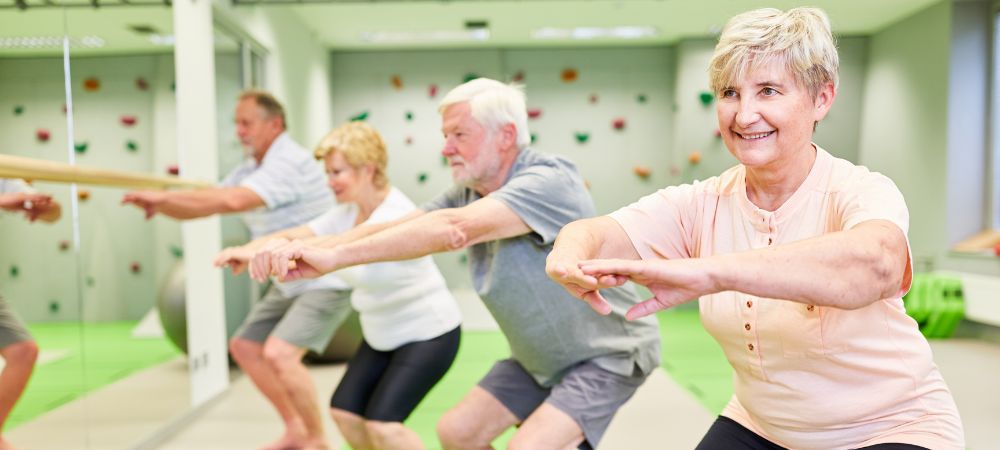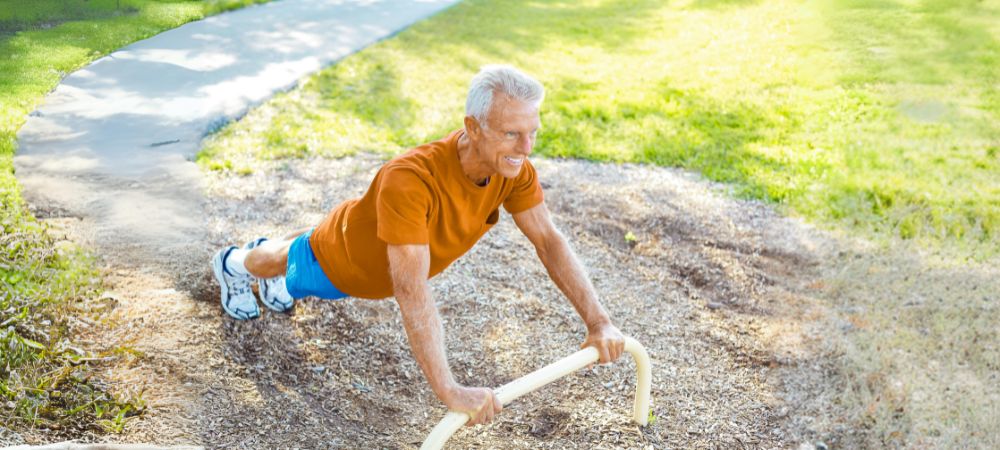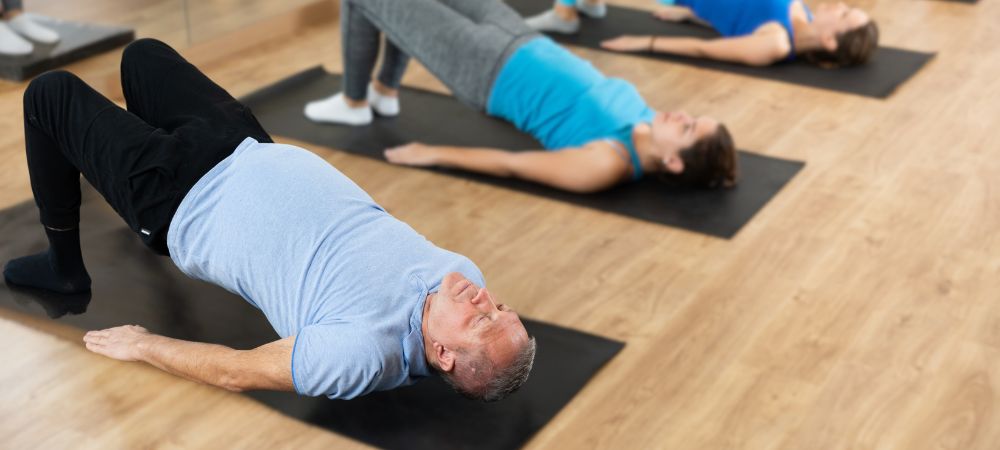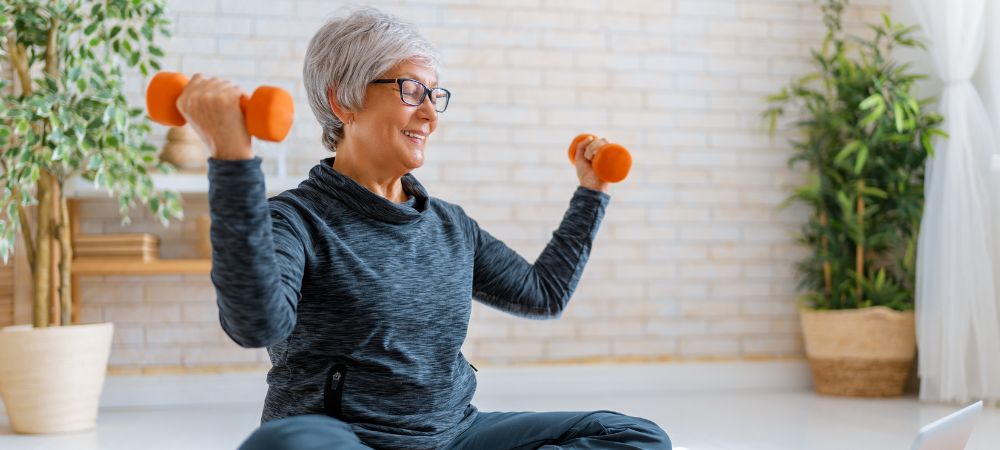Recently updated on August 13th, 2024 at 07:25 am
Weight training for senior strength training offer numerous benefits to seniors, including improved mobility, enhanced balance, reduced risk of falls, and better overall health. Regular strength training in a fitness routine can help maintain muscle mass, support joint health, and boost energy levels. Even creating a fall prevention program for weight training is essential to ensure safety and minimize the risk of injury. Focusing on crucial, safe exercises for older adults can effectively enhance physical fitness while reducing the risk of injury. This guide will explore seven essential exercises designed to build strength and support functional movement for seniors.
Squats
 Benefits:
Benefits:
- Strengthens the lower body, including the quadriceps, hamstrings, and glutes.
- Improves balance and stability.
- Enhances functional movements such as standing up from a seated position.
How to Perform:
- Starting Position: Stand with feet shoulder-width apart and toes slightly turned out.
- Movement: Slowly bend your knees and lower your hips as if sitting back in a chair. Keep your back straight and chest up.
- Return: Push through your heels to return to the standing position.
Modifications:
- Chair Squats: Perform the squat with a chair behind you, lightly touching it for support.
- Wall Squats: Stand with your back against a wall and slide down into a squat position, using the wall for support.
Incline Push-ups
 Benefits:
Benefits:
- Strengthens the upper body, including the chest, shoulders, and triceps.
- Enhances core stability and upper body strength.
How to Perform:
- Starting Position: Place your hands on a stable, elevated surface, such as a bench or wall, with your arms slightly wider than shoulder-width apart.
- Movement: Lower your chest towards the surface by bending your elbows while keeping your body straight.
- Return: Push through your hands to return to the starting position.
Variations:
- Wall Push-ups: Perform the exercise against a wall for a more straightforward modification.
- Elevated Push-ups: Use a lower surface like a bench for a more challenging variation.
Seated Rows
Benefits:
- Strengthens the back muscles, including the lats and rhomboids.
- It improves posture and helps counteract the effects of prolonged sitting.
How to Perform:
- Equipment: Use a resistance band or cable machine.
- Starting Position: Sit on a chair or bench with your feet flat. Hold the resistance band or cable with both hands.
- Movement: Pull the band or cable towards your torso, squeezing your shoulder blades together. Keep your back straight.
- Return: Slowly extend your arms to return to the starting position.
Note: Adjust the resistance based on your fitness level.
Lunges
Benefits:
- Strengthens the legs, including quadriceps, hamstrings, and glutes.
- Improves balance and stability.
How to Perform:
- Starting Position: Stand with feet hip-width apart.
- Movement: Step one foot forward and lower your hips until both knees are bent at approximately 90 degrees. Ensure your front knee does not extend past your toes.
- Return: Push through the heel of your front foot to return to the starting position.
Safety Tips:
- Perform lunges slowly to maintain control.
- Use a chair or wall for balance if needed.
Glute Bridges
 Benefits:
Benefits:
- Strengthens the glutes, hamstrings, and lower back.
- Improves hip stability and lower body strength.
How to Perform:
- Starting Position: Lie on your back with knees bent and feet flat, hip-width apart.
- Movement: Lift your hips towards the ceiling by squeezing your glutes and pushing through your heels. Keep your shoulders and upper back on the floor.
- Return: Lower your hips back to the ground slowly.
Benefits: Effective for improving lower body strength and core stability.
Shoulder Overhead Press
Benefits:
- Strengthens the shoulder muscles, including the deltoids and triceps.
- Enhances upper body strength and stability.
How to Perform:
- Equipment: Use light dumbbells or resistance bands.
- Starting Position: Stand or sit with dumbbells at shoulder height, palms facing forward.
- Movement: Press the weights overhead until your arms are fully extended. Keep your core engaged, and avoid arching your back.
- Return: Lower the weights back to shoulder height.
Variations:
- Seated Press: Perform the exercise while seated for added support.
- Single-arm Press: Focus on strength balance one arm at a time.
Bird Dog
Benefits:
- Improves core stability and balance.
- Strengthens the lower back, glutes, and shoulders.
How to Perform:
- Starting Position: Start on all fours with your hands directly under your shoulders and knees under your hips.
- Movement: Extend one arm forward and the opposite leg back simultaneously, keeping your body straight.
- Return: Lower your arm and leg back to the starting position and repeat on the other side.
Benefits: Enhances core strength and coordination.
Incorporating these basic best strength training exercises for seniors into your fitness routine can significantly benefit seniors by improving strength, balance, and overall health. Remember to start with lighter weights or resistance and gradually increase as you build strength. Always consult a healthcare professional before starting any new exercise program, especially if you have existing health conditions or concerns. Regular exercise and a balanced diet can lead to a healthier, more active lifestyle.
Safety Tips for Strength and Weight Training

Strength and weight training for seniors over 70 and exercises for lower back pain for seniors can provide numerous benefits. Still, it’s essential to prioritize safety to avoid injuries and ensure effective workouts. Follow these safety tips to maximize your training experience:
- Prioritize Proper Form
Maintaining proper form is crucial for preventing injuries and ensuring you are working the correct muscle groups. Incorrect form can lead to strain or damage, especially for seniors with varying levels of flexibility and strength.
- Focus on Technique: Before adding weights or resistance, master the basic movements and techniques.
- Use a Mirror: Performing exercises in front of a mirror can help you check your form and make necessary adjustments.
- Consider Professional Guidance: Working with a trainer or physical therapist can provide personalized instruction and feedback.
- Start with Low Weights
Beginning with lighter weights or resistance bands allows you to focus on learning the proper technique and gradually build strength.
- Gradual Progression: Increase weights or resistance gradually to avoid overloading your muscles and joints.
- Listen to Your Body: If an exercise feels uncomfortable or painful, reduce the weight or resistance and adjust the exercise as needed.
- Warm-up and Cool-down
Warming up and cooling down are essential parts of any exercise routine, helping to prevent injuries and aid recovery.
- Warm-up: Engage in 5-10 minutes of light cardio (such as walking or cycling) followed by dynamic stretches to prepare your muscles and joints for exercise.
- Cool-down: After your workout, spend 5-10 minutes doing gentle stretching exercises for seniors and deep breathing to help your body return to its resting state and reduce muscle soreness.
- Consult with a Healthcare Provider
Before starting any new exercise regimen, especially if you have existing health conditions or concerns, it’s essential to consult with a healthcare provider.
- Health Assessment: Discuss your fitness goals and any potential limitations or health issues to ensure your exercise program is safe and appropriate.
- Personalized Recommendations: Your healthcare provider can offer tailored advice and modifications based on your needs and medical history.
Benefits of Strength Training for Seniors
Incorporating weight training for seniors’ strength training at home and into your routine offers a range of benefits that can enhance overall health and well-being. Here’s how strength training positively impacts seniors:
- Improved Muscle Mass
Muscle mass naturally declines as we age, affecting mobility and strength. Strength training helps:
- Preserve and Build Muscle: Regular resistance exercises stimulate muscle growth and maintenance, supporting functional independence.
- Increase Metabolic Rate: More muscle mass helps boost metabolism, aiding in weight management and overall energy levels.
- Better Bone Density
Bone density often decreases with age, increasing the risk of fractures and osteoporosis. Strength training:
- Enhances Bone Strength: Weight-bearing exercises stimulate bone formation and improve bone density.
- Reduces Osteoporosis Risk: Strength training can help prevent or slow down bone loss associated with aging.
- Enhanced Balance and Stability
Falls are a significant concern for seniors, and improved balance can significantly reduce fall risk. Strength training:
- Strengthens Core Muscles: Exercises that target the core enhance balance and stability, reducing the likelihood of falls.
- Improves Coordination: Better muscle control and strength improve coordination and confidence in movement.
- Overall Health Improvements
Beyond muscle and bone benefits, strength training contributes to a variety of health improvements:
- Cardiovascular Health: Regular strength training supports heart health by improving circulation and reducing blood pressure.
- Mental Well-being: Exercise can boost mood and cognitive function, reducing symptoms of anxiety and depression.
- Functional Independence: Maintaining strength and mobility supports daily activities, helping seniors stay active and independent.
Incorporating strength training into your routine can lead to these significant health benefits, supporting an active and fulfilling lifestyle.
By following these safety tips and understanding the benefits of strength training, seniors can engage in effective workouts that enhance overall health and well-being. Before starting any new exercise program, remember to consult a healthcare provider and enjoy the numerous advantages of regular strength training!
Conclusion
Incorporating strength and weight training into your routine offers tremendous benefits for seniors, including improved muscle mass, bone density, enhanced balance, and overall health improvements. The seven basic exercises outlined—squats, incline push-ups, seated rows, lunges, glute bridges, shoulder overhead press, and bird dog—enhance strength, stability, and functional mobility while being accessible and adaptable for various fitness levels.
Starting with proper form at home strength training for seniors, using low weights, and incorporating warm-up and cool-down routines are crucial for a safe and effective exercise program. Additionally, consulting with a healthcare provider before beginning any new exercise regimen ensures the program is tailored to your needs and health conditions.
By integrating these exercises into your daily or weekly routine, you can enjoy long-term benefits that enhance your quality of life, support physical independence, and improve overall well-being. Consistent strength training contributes to maintaining an active lifestyle and promotes health and vitality as you age.
Ready to get started on your path to better health and strength? Share this post with friends and family to spread the word about the benefits of strength training for seniors. For personalized advice and fitness plans tailored to your needs, sign up for our newsletter or consult with Loving HomeCare Inc. Our experts are here to help you design a fitness program that supports your health goals and enhances your quality of life. Embrace the journey to a stronger, healthier you today!
Frequently Asked Questions
– Improper Technique: Incorrect form or technique can lead to instability and falls.
– Fatigue: Overexertion or lack of rest can impair coordination and balance.
– Poor Equipment Use: Unsecured weights or malfunctioning equipment can increase the risk of accidents.
– Cluttered Environment: Obstacles or a disorganized workout area can cause trips and falls.
– Weak Core and Lower Body Strength: Insufficient strength in the core and lower body can compromise stability during exercises.
– Gradual Progression: Increase weights gradually to allow your body to adapt and strengthen without compromising form.
– Focus on Technique: Ensure proper technique and form are maintained at all times, significantly as weights increase.
– Use a Spotter: Use a spotter to help with safety and technique for heavy lifts.
– Incorporate Strength and Balance Training: Strengthen your core and lower body and work on balance exercises to improve overall stability.
– Monitor Fatigue Levels: Avoid lifting heavy weights when you are fatigued or after a strenuous workout, as this can impair your ability to maintain balance.
– Stop Immediately: Cease the exercise to prevent potential injury.
– Assess Your Form: Check your form and technique to ensure they are correct. Use mirrors or ask for feedback from a trainer if needed.
– Reduce the Weight: Lower your lifting weight to a level where you feel more stable and comfortable.
– Use Support: Consider using supportive equipment like weight belts or wrist straps if appropriate for the exercise.
– Consult a Professional: Seek advice from a fitness trainer or coach to address any issues with technique or balance and to develop a plan for improving stability.

